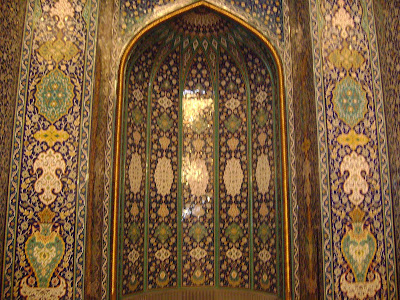The gleaming city of
Muscat sits in folds of the western el-Hajar mountains, sloping to a
natural harbour. Facing north and east into the Gulf of Oman, this is largely a twentieth-century developed city. Refreshingly, it avoids the
ostentatious sky-high architecture of many oil-rich cities. Oman's
iconic frankincense burner dominates one hill, symbolizing a long
history of tribal/nomadic trading.
 |
| Oman's national animal the oryx; a handpainted display at the museum |
The enlightened
Sultan Qaboos bin Said has led his country for almost fifty years.
All power rests in him as king and benign dictator. He modernized
Oman from poverty to prosperity with impressive infrastructure,
universal education and health care, and freedom of religion. His
likeness, at varying ages and stages, can be seen everywhere in
Muscat.
Playing a mainly
neutral position in Middle East politics, and also between the West
and Iran, peaceful diplomacy is more the Sultan's style. The question
of succession hangs over his people: he has no children, but he has a
number of other family candidates to choose from. His principal
palace here in Muscat is not open to the public. On the royal shield
(and national flag), the khanjar (curved dagger) is another distinctive Omani symbol.
Known for centuries in this area, it represents heritage and,
depending on the engravings and precious-metal workmanship, social
status.
A central gathering
place in Muscat is one of my favourite markets, Mutrah Souk. Colours
glow and textures commingle, tempting one to choose a souvenir that
will recall the ambience. The stall fronts can be deceptive; behind
them, merchants often have a large inventory they will eagerly search
to find just want you want. If you look like a serious shopper, they
will sit you down and serve you tea. To be sure, haggling over prices
is customary, but there's little pressure to make a purchase, as
Omanis are generally polite and respectful.
By evening light,
traffic seems to hush on the Corniche and the call to prayer echoes
across the harbour. Peace. The dhow is another well-loved symbol, the
fisherman's traditional boat.
 |
| A dhow sits in front of the Sultan's private yacht. |
Muscat, don't
change! Oman, stay stable!
©
2019 Brenda Dougall
Merriman















No comments:
Post a Comment